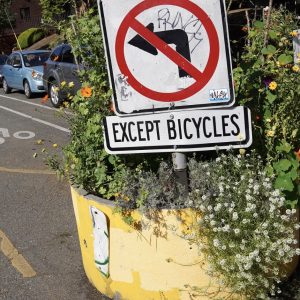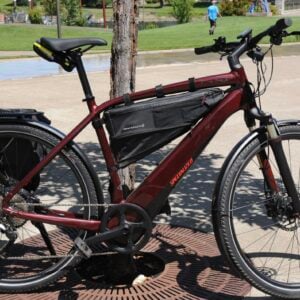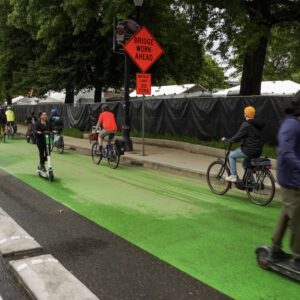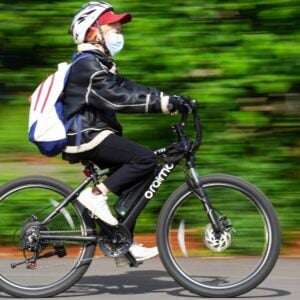BTA Policy Director Scott Bricker just sent me the letter he drafted to ODOT regarding ODOT’s proposed rule change that would ban bikes on several Metro area freeways and highways that are currently used as bike routes. Here is an excerpt:
“We (the BTA) do not completely comprehend the impetus for the proposal. We feel that the level of use and lack of documented safety concerns are disconnected from prohibiting bicyclists, for whatever reason, to occasionally use these routes.”
Here is the complete letter (45K PDF).
My previous post on this issue has sparked some good dialogue. Many riders use these routes because there is no safe and adequate alternative. One such rider is Susan Otcenas. Below is an excerpt from her comment that illustrates why it is important for us to keep a close eye on ODOT, regardless of if you use these routes or not:
“ODOT is citing “safety concerns”. Yeah, maybe I personally wouldn’t want to ride on some of these roads, but that’s not the point. The point is that “safety concerns” is a slippery slope. What if “safety concerns” gradually brought about the banning of bikes on all sorts of roads we use all the time? Don’t laugh, or think it can’t happen – I was in Spokane last weekend and saw “NO BICYCLES” signs on major thoroughfares there – not freeways, just busy roads. A friend just had a conversation with a motorist this weekend, who told him he wasn’t “allowed” to ride on roads without shoulders. Is this the world we want to live in?”
I encourage everyone to stay tuned for opportunities to let ODOT know how you feel about this issue. I plan on attending the meeting of the Oregon Pedestrian and Bicycle Advisory Committee where this issue will be discussed. If you can’t make it, please leave your comments here and stay tuned for a report. If you would like to attend, here are the details:
OBPAC Meeting
Friday, April 7th
Location: Lovejoy Room, Portland City Hall, 1221 SW 4th Ave., Portland
Time: 10am – Highway Closure agenda item






Thanks for reading.
BikePortland has served this community with independent community journalism since 2005. We rely on subscriptions from readers like you to survive. Your financial support is vital in keeping this valuable resource alive and well.
Please subscribe today to strengthen and expand our work.
Certainly this is a wake up call to the BTA, as the Tri Met idea they signed off on should have been.
Under the guize of safety, we are being pushed off roads.
Once again, Platinum status will not be acheived without safe and free movement across all roads in Portland…
I mentioned this on the prvious post about this topic. Why is this being done now? I ride the HW 26 route many times in the Morning (many times I take the longer route through Washington Park). Seems odd to me, that the zoo to jefferson route going east-bound is 100% safe. The sholder is wide enough that I have never had problems with cars. Only after the tunnel under the freeway on Jefferson is where it gets a bit stressful.
Keep the HW 26 route open!
I also believe that the Sunset Bike Path could and SHOULD be continued down to the city.
~n
I, the organization I represent, and many others have been long and vocal in our opposition to any ban with regard to bicycles on the highway shoulders be they freeways or limited access arterials, such as Hwy 217. In fact, our input in re Hwy 217 was helpful in gaining assurances from ODOT and Washington County LUT that the final design would NOT exclude bicycle access.
In 2000-’02, I sat on the Washington County Transportation Plan Update Advisory Committee. I successfully lobbied to exclude language in the Plan that read, “Although bicysles are not typically allowed on freeways..” because the only “freeway” in Washington County (I-5) allows bicycles up to the Hwy 217 interchange. The remaining +/- 1.5 miles do prohibit bicycles and pedestrians, for that matter.
I was not so successful in striking language in the Table 7 caption on the Plan that reads “Although portions of Sunset Highway (US 26) are considered to have paved shoulders on which bocycles are allowed, high traffic volumes and speeds as well as conflicting traffic movements make riding dangerous on this facility.” Freeways weren’t included in the inventory summary of “Bicycle Lanes/Paved Shoulder Inventory Summary by Functional Classification” table.
While this isn’t prohibitive language, the word dangerous is discouraging. There are other routes to travel in any direction certainly, but the law allows us the right SHOULD WE SO CHOOSE TO EXERCISE IT to do so.
I meet later tonight at a Stakeholders Work Group (SWG) that ODOT is hosting with regard to the Glencoe Rd. overpass at Hwy 26 in North Plains. My input will be to make sure that access along the shoulder is NOT eliminated along that stretch. We are against any further loss of shoulder along US 26 or any other “freeway” in Washington County to bicycle access.
Below is the exact agenda of the OPBAC meeting on April 7, 2006. Please be advised that the public comment / open access is the 12:15 slot. We will be cramming in a lot of information about the above and other committee concerns in before that. It would excellent for concerned people to show up at 12:15 and submit written statements to us regarding the restiction of bikes/pedestrians on the aformentioned public access.
I would be happy to forward any concerns as well if you wish to email me directly as well.
ajz@zelada.com
A. J. Zelada, OD
OBPAC Public member
AGENDA
Oregon Bicycle and Pedestrian Advisory Committee
April 7, 2006
Lovejoy Room, Portland City Hall
1221 SW 4th Avenue, Portland
9:30-10:00 ADMINISTRATIVE BUSINESS
Welcome; Call to Order & Introduction of Guests; Additional Agenda Items; Election of Officers; Next Meeting Date;
10:00-10:45 PROPOSED BICYCLIST BAN ON PORTLAND AREA FREEWAYS
Rolland Arney
10:55-11:00 BREAK
11:00-12:15 REVIEW SELECTION CRITERIA FOR GRANT PROGRAM
Committee members and staff.
12:15-12:45 PUBLIC COMMENT PERIOD
12:45 ADJOURN
I have seen cyclists travel Eastbound on 26 between the zoo exit and the exit before the tunnel FASTER than cars during commute hours. How exactly can it be described as “dangerous” when a cyclist can travel along a very wide shoulder at the same speed as auto traffic?
Craig